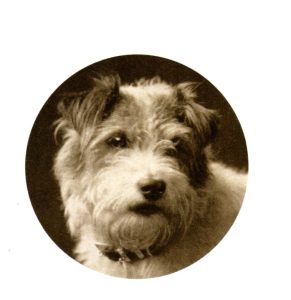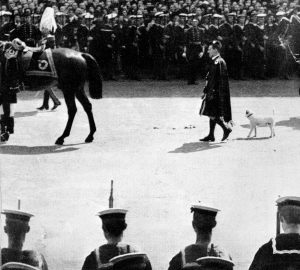According to a report in the Oban Times of 1902, the Royal Yacht, ‘Victoria and Albert’, with King Edward VII and Queen Alexandra on board, anchored on a late autumn day in Kilninian Bay, Loch Tuath off the island of Mull.
The reason for the visit was to undertake an expedition to shoot seals on the Treshnish Isles and for this purpose The Hon Sydney Holland, tenant of Torloisk, along with Mr Donald MacColl, his gamekeeper, were summoned to provide local knowledge.

Bad weather prevented the Royal Party from landing. However, Messrs Holland and MacColl spent some time on board entertaining The Royal Family.
On leaving the Royal Yacht the King gave Donald MacColl a gold sovereign at the same time saying; “When you go ashore drink my health with that”. The coin was not changed in the local hotel but enshrined in a casket with a suitable inscription and remains in the possession of the MacColl family to this day.
While the Royal Yacht lay at anchor off Torloisk a local fishing boat was hailed and came alongside. In addition to a supply of lobsters and crabs, the fisherman had with him a rough-haired fox terrier which the Queen took a liking to. A price was agreed and both dog and lobsters were taken on board.
Written history does not relate if the terrier became the King’s constant companion, famous for his appearance in photographs of HM’s funeral procession through London.
If it was his name was Caesar [1898–1914]. According to some sources Caesar came from the kennels of Kathleen, Duchess of Newcastle, and was given to King Edward VII by Lord Dudley following the death of the King’s dog Jack, who had died after choking on food.
However, there is enough circumstantial evidence to suggest he may indeed have been bred on the Island of Mull.
During his life with the King, he had a footman assigned to him to clean him and was allowed to sleep on an easy chair next to the King’s bed. He wore a collar that read “I am Caesar. I belong to the King”.
Caesar would always greet the King excitedly, and the King would often say: “Do you like your old master, then?” while the dog was jumping up and down in excitement.
Edward would never hit Caesar, but instead tell him off by shaking his walking stick at him while calling him a “naughty dog”.
Lord Charles Hardinge of Penshurst, reminisced about spending time with the dog whilst on the royal yacht. “Whenever I went into the King’s cabin, this dog always went for my trousers and worried them, much to the King’s delight.
“I used not to take the slightest notice and went on talking all the time to the King, which I think amused His Majesty still more.”
Caesar frequently caused problems for the King, escaping in Marienbad whilst chasing white peafowl and on another occasion killing rabbits owned by Lord Redesdale’s daughters.
The King even considered Caesar to be an obstacle to the Entente Cordiale. He asked his personal attendant, Lawrence Wrightson, to look after Caesar should he die before the dog.
The King ordered hardstone figures of his favourite dogs and racehorses from the world-renowned House of Fabergé.
Caesar was at HM’S side on the Norfolk estate when the initial wax models were revealed by the company. The model was made of chalcedony, rubies, enamel and gold, and included Caesar’s collar in the design. The finished item did not arrive until after the King’s death, and was purchased by Dame Margaret Greville, who gave it to Queen Alexandra. A painting of the dog was also created by Reuben Ward Binks [a well-known Westmorland artist in canine portraiture] for the King.

After the death of his master on May 6, 1910, Caesar refused to eat, and would spend time whining outside the King’s bedroom door. At one point he managed to sneak in and was found hiding under his bed by Queen Alexandra.
The Queen encouraged him to eat once more and restored him to his normal self.
Caesar attended the funeral of Edward VII on May 20, led by a kilted-Highlander walking behind the carriage that carried the King’s coffin.
He was placed in front of the heads of state and ambassadors in the procession, including King George V and eight other Kings.
Within a month of the funeral an unofficial book was published, ‘Where’s Master?’ giving a first-person account, apparently written by Caesar, from the King’s death up to the funeral.
The book was highly successful, running to nine reprints, amounting to several hundred thousand copies in the first year.
After his master’s death, another portrait of the dog was painted by Maud Alice Earl (1863–1943) a British-American artist, known for her canine paintings, which are still enjoyed by dog enthusiasts. The painting entitled Silent Sorrow, features Caesar resting his head on the King’s favourite chair.
Caesar remained in the Royal household after the death of the King, although Alice Keppel, long-time mistress to the King, had enquired of Queen Alexandra about what was to happen to Caesar.
Despite her previous dislike of the dog, the Queen took an interest in the terrier’s care and tended to spoil him with treats, confessing to a friend that she was making up for the King being so strict towards him. Caesar died following an operation in April 1914.
The Fabergé figurine now forms part of the Royal Collection, while Caesar was included in the tomb effigies of the King and Queen in St George’s Chapel, Windsor Castle. In the sculpture, Caesar lies at the feet of the King.
We will probably never know for sure if Caesar came from Mull unless, of course, he sired some offspring prior to boarding the Royal Yacht in Loch Tuath all these years ago.
That depends on some sharp-eyed local reader who has one of his descendants and recognises the breed from the photographs accompanying this article and writes to the Editor.